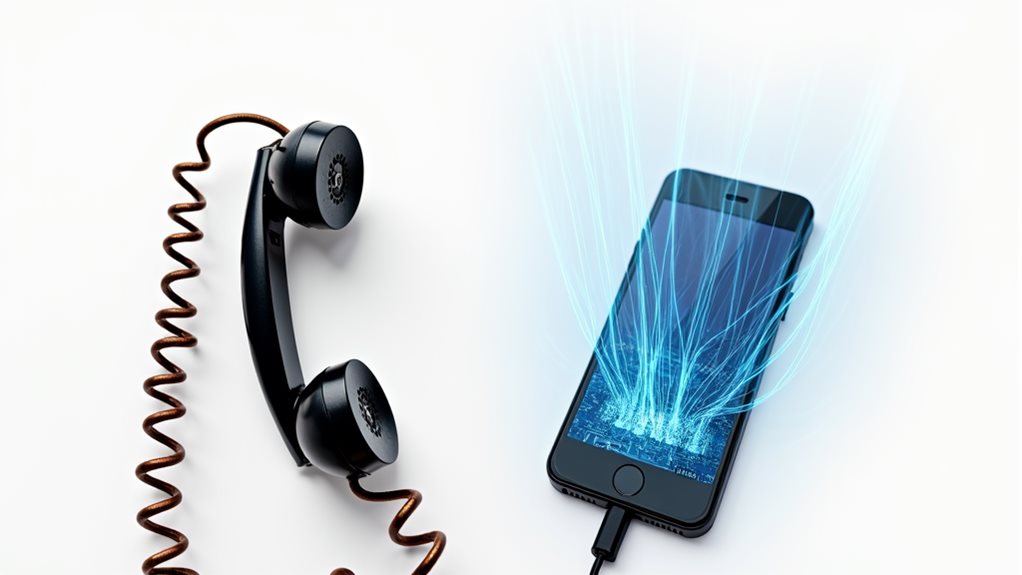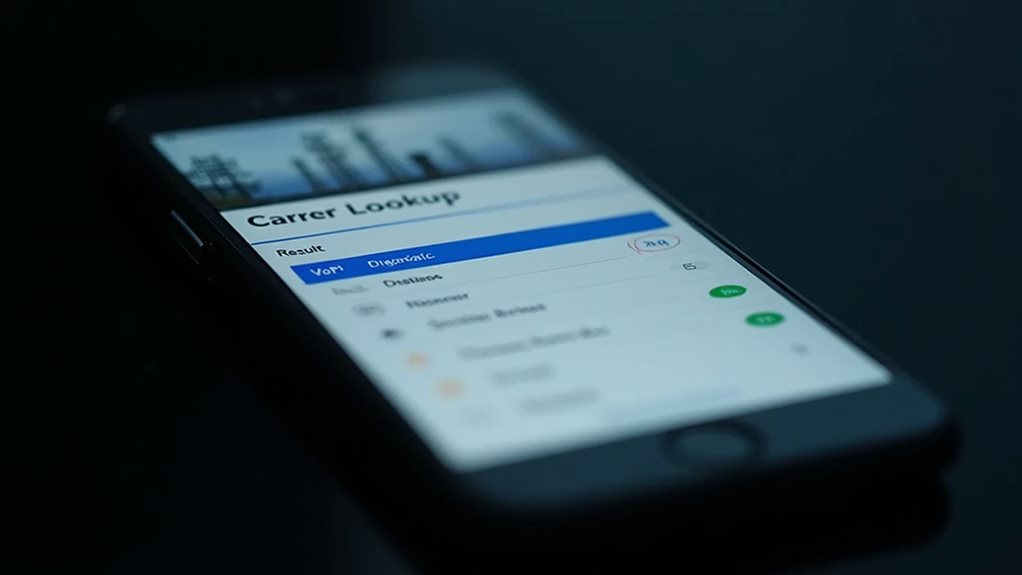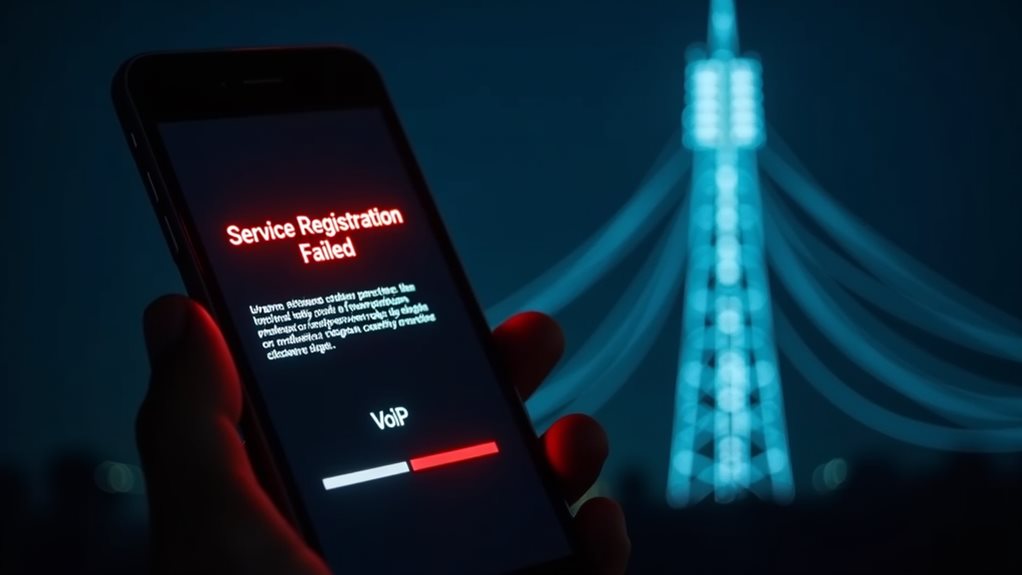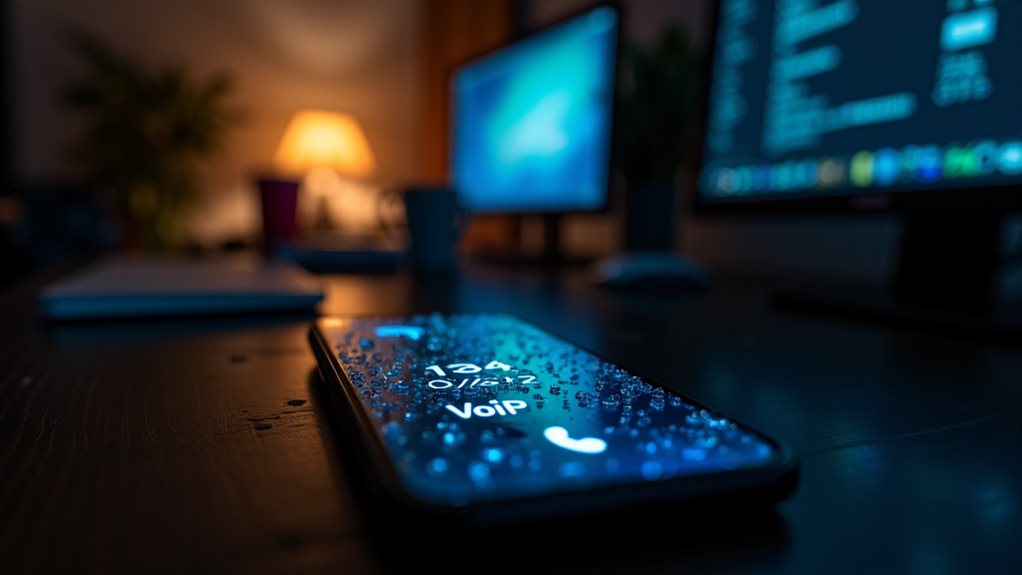Your phone number may display as VoIP when verification systems detect internet-based calling patterns instead of traditional copper-wire signals. This commonly occurs if you're using services like Google Voice, a digital phone provider, or certain mobile apps that route calls through the internet. Modern phone systems use advanced database checks to identify line types, achieving 99.9% accuracy in classification. While VoIP designation isn't necessarily problematic, it can affect service registration and lead to occasional blocking by security-conscious platforms. If you're experiencing issues with your number being flagged as VoIP, several factors could be influencing this classification.
Understanding VoIP Phone Numbers
When making or receiving calls, you might notice your phone number displaying as VoIP instead of a traditional line. This isn't a cause for concern – it's simply indicating that your calls are being transmitted over the internet rather than through conventional copper phone lines.
VoIP benefits include remarkable flexibility and cost savings compared to traditional phone systems. You can save up to 60% on service costs compared to traditional phone lines. You'll find that your number isn't tied to a specific location, allowing you to make and receive calls from any device with an internet connection. Your calls utilize packet switching technology to convert voice data into digital packets for efficient transmission.
Whether you're using your smartphone, tablet, or computer, you're always connected to your phone number.
The VoIP features you'll enjoy extend far beyond basic calling capabilities. You'll have access to professional tools like call forwarding, conference calling, and automated attendants.
Plus, you can choose from various number types – local numbers that maintain a regional presence, toll-free numbers for national reach, or even international numbers to establish a global footprint.
With options like direct inward dialing and vanity numbers, you're equipped with a complete communication solution that grows with your needs while maintaining the familiarity of a traditional phone number.
Common Signs of VoIP Designation
Several key indicators can help you identify why your phone number appears as VoIP. You might notice consistent caller ID issues, where your number displays differently to various recipients, often due to discrepancies in CNAM databases that phone carriers use. These inconsistencies can affect how others perceive your calls and potentially impact your VoIP call quality. The use of an Analog Telephone Adapter can sometimes contribute to these identification issues. Even long-standing traditional phone numbers may suddenly be marked as VOIP after transitioning to new devices.
When you've recently switched carriers or gone through a number porting process, you'll likely encounter temporary VoIP designation issues. This is particularly common if you're using an eSIM-enabled device, as some systems automatically flag these configurations as VoIP services. You're not alone in experiencing these challenges, as many users face similar situations during provider changes.
Pay attention to how your number appears in verification processes for apps and services. If you're consistently receiving error messages or getting flagged as VoIP, it's worth checking your ITSP settings and provider configurations.
Contact your service provider's technical support team, as they can help verify your number's correct designation and resolve any misclassification issues affecting your communications.
Traditional Vs Voip Numbers

Understanding the differences between traditional and VoIP numbers helps explain why your phone might show up as VoIP. While traditional numbers operate through physical copper wire infrastructure, VoIP numbers function entirely over the internet, creating distinct advantages and challenges for each system.
One of the key traditional advantages is reliability, especially in areas with inconsistent internet connectivity. You'll find that traditional numbers don't depend on internet quality, making them more stable for basic calling needs. Initial setup costs can reach up to $2,000 per user with traditional PBX systems. VoIP systems leverage cloud-based technology to manage and route all communications, thereby enhancing operational efficiency for users.
However, they're less flexible and typically more expensive to install and maintain, requiring professional technicians and physical hardware.
In contrast, VoIP numbers offer greater flexibility and cost-effectiveness, allowing you to make calls from various devices and locations. You'll appreciate the advanced features like video calling and messaging, plus the ability to scale your service easily.
But there are VoIP disadvantages to take into account: you'll need a stable internet connection for clear calls, and service quality can suffer from issues like jitter and latency.
Despite these challenges, many users find that VoIP's modern capabilities and cost savings outweigh the potential drawbacks, explaining why more phone numbers are evolving to this technology.
Why Services Block VoIP
Through extensive security measures, many services block VoIP numbers to protect against fraud and abuse. You'll find that VoIP security concerns, like call interception and caller ID spoofing, drive organizations to implement strict blocking protocols. Access Control Lists help regulate traffic flow at network boundaries. The average breach cost rises to $9.4 million in the U.S., making protective measures essential. Unencrypted VoIP systems are particularly vulnerable to data breaches, which can significantly escalate the impact of any security violation.
When you're dealing with potential vishing attacks and denial of service threats, these protective measures become vital for safeguarding sensitive information.
Network configuration plays an important role in VoIP blocking, as firewalls and port restrictions help maintain system integrity. If you're experiencing connection issues, it's often due to NAT complications or QoS problems that require technical adjustments.
Many organizations also block VoIP to prevent unwanted calls from disrupting their operations, including spam from illegal call centers and persistent telemarketers.
You'll discover various technical limitations that enable VoIP blocking, from device-level settings to provider-based solutions. Whether you're using app-based blocking or manual rejection features, these tools help you maintain control over incoming communications.
Understanding why services block VoIP can help you navigate these restrictions and guarantee your communications remain both secure and efficient while respecting necessary protective measures.
Phone Carrier Database Checks

Phone carrier database checks serve as your first line of defense in understanding why your number appears as VoIP.
These sophisticated lookup services tap directly into carrier databases and the Number Portability Administration Center to verify your phone number's current status, carrier information, and line type. Non-VoIP numbers are often preferred for their enhanced privacy and security features.
You'll find that these checks use real-time data to accurately determine whether your number is classified as traditional landline, cellular, or VoIP service. The validation process achieves 99.9% accuracy rates when checking if phone numbers are real and actively connected to carriers. The system leverages instant validation capabilities to process thousands of number verification requests per second.
Database Lookup Services
Database lookup services serve as digital detectives in determining why your number might show as VoIP. These sophisticated systems tap into multiple trusted sources, including telecom operators and the Number Portability Administration Center (NPAC), to guarantee database accuracy that you can rely on.
When you're trying to understand your number's classification, these lookup services work behind the scenes to cross-reference your digits with real-time carrier information.
You'll find that reputable lookup services like NumLookup and Data247 offer extensive coverage for mobile, landline, and VoIP numbers across hundreds of countries. They're constantly updating their databases through direct carrier relationships, which means you're getting the most current information available.
If you're concerned about your number's status, these services can provide detailed insights about your carrier and number type. Additionally, using reverse phone lookup services can enhance your understanding of VoIP classification by providing caller information linked to specific numbers.
Through API access and browser extensions, you can easily check your number's classification. While some services require a subscription or per-lookup fee, they're invaluable tools for businesses and individuals who need to validate phone numbers or understand why certain systems might misidentify their numbers as VoIP.
Carrier Information Verification Methods
When you need to verify your phone carrier information, multiple robust methods can accurately determine your number's status. Modern carrier verification systems combine real-time data checks with sophisticated validation processes to guarantee you're getting precise results about your phone line's classification.
You'll find that phone validation services work through several interconnected steps to confirm your carrier details. These systems check if your number is active, verify whether it's a mobile or landline connection, and determine if it's operating through traditional cellular networks or VoIP services.
When you're concerned about your number showing up as VoIP, these verification methods can help identify the root cause by examining your carrier's database records and conducting live line tests. Additionally, understanding that VoIP systems are vulnerable to data breaches is crucial for ensuring your communication remains secure.
The process typically includes two-step authorization protocols and real-time number validation to guarantee accuracy. You're not just getting basic carrier information; you're receiving extensive details about your line type, including whether it's pre-paid or post-paid.
This thorough approach helps you understand exactly how your number is classified within carrier databases, giving you clarity about your phone's status.
Switching From Voip Numbers
Switching from your VoIP number to a new provider requires careful planning and proper documentation. Before initiating the porting process, you'll need to guarantee you've gathered essential paperwork, including your current account number, billing information, and a complete list of the numbers you're planning to transfer.
When you're ready to make the switch, you'll work with your new provider to complete a Letter of Authorization (LOA). During this time, it's vital to perform compatibility checks to verify that your desired numbers can transfer smoothly to the new system.
You'll want to confirm that you don't have any outstanding balances with your current provider, as this could delay the changeover.
The timeline for switching typically spans 5-7 business days, though more complex transfers might take up to four weeks. Throughout this period, you'll continue using your existing service until the port is complete. Additionally, understanding the provider's reliability features is crucial to ensure a seamless transition without service interruption.
Impact on Service Registration

Service registration problems can considerably affect how your phone number is classified in VoIP systems. When you're experiencing issues with your phone showing up as VoIP, it's often tied to the intricate process of service registration and how your device communicates with the network.
Your SIP configuration plays an essential role in determining how your phone registers with the service provider. If you're facing registration issues, you'll want to make sure that your DHCP server options and DNS services are functioning correctly.
Understanding the registration process isn't just about technical compliance; it's about making certain your device properly connects to the network infrastructure. Optimizing firewall settings can also greatly enhance your device's ability to connect seamlessly.
When troubleshooting service registration problems, you'll need to verify that your SIP server parameters, including your URI and password, are correctly configured. Remember that client-server configuration must be precise on both ends for successful registration.
If you're still experiencing difficulties, check your network connectivity and confirm your device is compatible with your SIP server. By following proper security protocols and maintaining stable network connections, you'll minimize the risk of your number being incorrectly classified as VoIP.
VoIP Number Detection Methods
You'll find several reliable tools to detect VoIP numbers, including established reverse phone lookup services like Whitepages and specialized platforms such as IPQS.
Common detection patterns, such as unfamiliar area codes or multiple zeros in the number sequence, can offer quick hints about a number's VoIP status, though these aren't always definitive indicators.
For more technical verification, you can use network packet analyzers like Wireshark to examine call data and IP addresses, which provides concrete evidence of VoIP usage. Additionally, analyzing network logs can reveal the communication flow that aids in confirming the VoIP status of a number.
Technical Lookup Tools
Several technical tools exist to help you determine whether a phone number is VoIP and trace its origin. When you're trying to identify a VoIP number, reverse lookup tools like Truecaller and Spokeo can provide essential information about the caller's identity and location.
These VoIP tracing techniques are particularly useful when you're dealing with unknown or suspicious calls. For more detailed investigation, you'll find IP address lookup tools invaluable. By accessing Call Detail Records and using services like NordVPN or ICANN Lookup, you can pinpoint the geographic origin of VoIP calls.
CNAM lookup offers another layer of verification, though you'll need specific permissions or technical skills to access this data. If you're technically inclined, packet analyzers can capture real-time data about incoming calls by enabling SIP filters.
While this requires setup beforehand, it's one of the most reliable methods for tracing VoIP numbers. Don't forget to check your VoIP provider's call logs, which can offer valuable insights about call patterns and timing. Additionally, conducting a reverse phone search can often reveal ownership details and further assist in understanding the nature of the call.
When combined, these tools create a thorough approach to understanding why your number might be showing up as VoIP.
Common Detection Patterns
Beyond technical lookup tools, understanding common detection patterns helps explain why your number appears as VoIP. When you're using VoIP technology, your calls leave distinct digital footprints that make them easily identifiable through routing analysis and network data. These patterns are like fingerprints that reveal the true nature of your phone service.
You'll find that detection methods often focus on analyzing call routing information and checking carrier databases. If you're using a virtual number, it'll show specific characteristics in number databases and lack traditional landline associations. Your call records might also display telltale signs, such as IP addresses instead of physical switching locations, and distinctive timestamp patterns that are typical of VoIP services.
When carriers and lookup services examine your number, they're looking at multiple indicators simultaneously. They'll check for VoIP-specific routing patterns, cross-reference carrier information, and analyze call detail records. It's important to note that analyzing the call logs and protocol data can also enhance the traceability of your number.
If you're wondering why your number is flagged as VoIP, it's because these systems are detecting these common patterns in how your calls are transmitted and processed through digital networks.
Frequently Asked Questions
Can I Receive Emergency Calls and Texts on My Voip Number?
You can receive emergency calls on your VoIP number, but there are VoIP limitations to take into account. Your service requires internet and power to function, so it's wise to have backup options for emergency services.
Do Voip Numbers Show Different Caller ID Information Than Regular Numbers?
Yes, your VoIP caller ID displays differently than regular numbers. You'll have more flexibility to manage how your information appears, but keep in mind this privacy feature means recipients might see it labeled as "VoIP."
Will My Voip Number Work Internationally Without Additional Charges?
You'll need to check your VoIP provider's international calling policies. While most VoIP services work globally with internet access, some providers have restrictions or additional charges for certain countries or phone types.
Can I Port My Existing Mobile Number to a Voip Service?
Yes, you can port your mobile number to VoIP providers! Just initiate the porting process during signup with your new provider. Keep your current service active until the transfer's complete to stay connected with everyone.
Does Using a Voip Number Affect My Ability to Use Banking Apps?
Yes, you'll likely face challenges with banking apps due to VoIP security concerns. Many banks won't accept VoIP numbers for verification, affecting your app access. It's best to use a traditional mobile number for banking.
Final Thoughts
If you're concerned about your number showing as VoIP, you've got several options to address this issue. You can contact your carrier to verify your number's classification, switch to a traditional phone line, or understand how this designation affects your service access. Remember, while VoIP numbers are increasingly common, they may face certain restrictions, so it's worth considering your communication needs when choosing between traditional and VoIP services.

